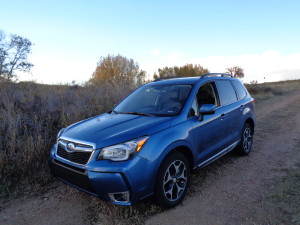
Give me a week in and out of a well-equipped Subaru and, it seems, I walk away from it with improved EyeSight.
The 2016 Forester 2.0XT Touring model, in a quartz blue pearl finish, was the subject of my attention.
It didn’t actually enhance my vision, I simply appreciated Subaru’s EyeSight Driver-Assist System, which maintains selected distance from the car out front, alerts driver of straying out of the driving lane, is capable of applying full braking force in emergencies, and can reduce power from the engine to minimize possible impacts.
While other makes warn of lane departures with buzzing, chiming, shudders in the steering wheel and nudges in the thighs, the Subarus flash “Lane Departure” on the screen in front of the driver and quietly chirp.
Two “eyes” peering out from the top of the windshield are cameras which aid in the effectiveness of the EyeSight.
It is but one of the upgrades for the Forester XT Touring model.
It also boasts a turbocharged engine mated to its continuously variable transmission (CVT), along with navigation, leather and panoramic moonroof. I’ve driven numerous Foresters over the years; this is the first at the $36,000 level.
I remember my first drive in a Forester, the 1998 model 18 years ago in June of 1997, to Georgetown. It was a week ahead of the showroom introduction of what then was a little sport ute. It was of 99-inch wheelbase and 175-inch overall length, with curb weight of 3,058 pounds.
Its boxer engine back then developed 165 horsepower, and I wrote, “Heading up I-70, the Forester is a middle-lane sport ute; in the left lane climbing toward Georgetown it risks getting run over by V-8-powered Grand Cherokees and Suburbans.”
Today it has grown some (5 inches longer and 600 pounds heavier) and is much stronger with a 250-hp turbocharged boxer engine.
The 2.0-liter direct-injected, intercooled, turboed engine offers a nice blend of smooth acceleration and CVT performance.
The symmetrical all-wheel-drive system lends reassurance for wintertime driving duties. And if the going gets really tough, the push of a button on the center console at any speed up to 13 miles an hour engages X-Mode, which increases traction by reducing wheelspin where needed and adding low-end torque. It remains effective until either the button is pushed again or speeds reach 25, when it automatically disengages. The Forester features a relatively short turn circle of 34 feet, 8 inches.
The Forester compact crossover, Subaru’s best seller, ranges in pricing from a base around $23,000 to the XT Touring’s $36,250.
Adding appeal to the review model are its optional sport-mode drive setting, dual-zone climate control, Subaru Starlink navigation and audio with Harman/Kardon amplifier and speakers, Bluetooth and rearview camera, leather seats (heated in front), power rear liftgate and push-button start.
Overall fuel mileage for the Forester was 23.5 miles per gallon.
Here are the specifications for the ’16 Subaru Forester 2.0XT Touring:
- Capacity 5-passenger
- Wheelbase 103.9 inches
- Length 180.9 inches
- Width 70.7 inches
- Height 68.2 inches
- Curb Weight 3,651 pounds
- Track 60.9 inches front, 61.1 rear
- Ground Clearance 8.7 inches
- Turn Circle 34.8 feet
- Drivetrain Symmetrical all-wheel-drive
- Engine 2.0-liter turbo boxer 4-cylinder
- Horsepower/Torque 250/258
- Transmission continuously variable
- Steering electric power-assist
- Suspension strut front, double wishbone rear
- Fuel mileage estimate 23/28
- Fuel mileage average 23.5
- Fuel Tank 15.9 gallons, premium unleaded
- Wheels 18-inch
- Tires Bridgestone Dueler 225/55R18
- Cargo Volume 31.5 cubic feet
- Warranty 3years/36,000 miles basic, 5/60,000 powertrain
Competitors Honda CR-V, Nissan Rogue, Ford Escape, Mazda CX-5, Jeep Cherokee, Chevrolet Equinox
Assembly Plant Ota, Gunma, Japan
Parts Content Japan 85%
Base Price of Lowest Model $22,395; Base Price of Review Model $33,795; Destination Charge $850; Sticker Price $36,250.